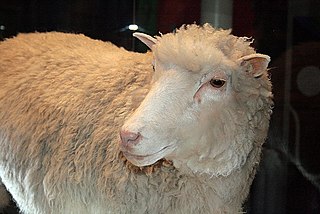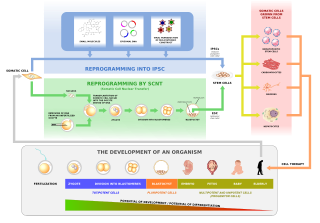Related Research Articles

Cloning is the process of producing individual organisms with identical genomes, either by natural or artificial means. In nature, some organisms produce clones through asexual reproduction; this reproduction of an organism by itself without a mate is known as parthenogenesis. In the field of biotechnology, cloning is the process of creating cloned organisms of cells and of DNA fragments.

Dolly was a female Finn-Dorset sheep and the first mammal that was cloned from an adult somatic cell. She was cloned by associates of the Roslin Institute in Scotland, using the process of nuclear transfer from a cell taken from a mammary gland. Her cloning proved that a cloned organism could be produced from a mature cell from a specific body part. Contrary to popular belief, she was not the first animal to be cloned.

Human cloning is the creation of a genetically identical copy of a human. The term is generally used to refer to artificial human cloning, which is the reproduction of human cells and tissue. It does not refer to the natural conception and delivery of identical twins. The possibilities of human cloning have raised controversies. These ethical concerns have prompted several nations to pass laws regarding human cloning.

In genetics and developmental biology, somatic cell nuclear transfer (SCNT) is a laboratory strategy for creating a viable embryo from a body cell and an egg cell. The technique consists of taking an denucleated oocyte and implanting a donor nucleus from a somatic (body) cell. It is used in both therapeutic and reproductive cloning. In 1996, Dolly the sheep became famous for being the first successful case of the reproductive cloning of a mammal. In January 2018, a team of scientists in Shanghai announced the successful cloning of two female crab-eating macaques from foetal nuclei.

The macaques constitute a genus (Macaca) of gregarious Old World monkeys of the subfamily Cercopithecinae. The 23 species of macaques inhabit ranges throughout Asia, North Africa, and Europe. Macaques are principally frugivorous, although their diet also includes seeds, leaves, flowers, and tree bark. Some species such as the long-tailed macaque will supplement their diets with small amounts of meat from shellfish, insects, and small mammals. On average, a southern pig-tailed macaque in Malaysia eats about 70 large rats each year. All macaque social groups are arranged around dominant matriarchs.

The crab-eating macaque, also known as the long-tailed macaque and referred to as the cynomolgus monkey in laboratories, is a cercopithecine primate native to Southeast Asia. A species of macaque, the crab-eating macaque has a long history alongside humans. The species has been alternately seen as an agricultural pest, a sacred animal, and, more recently, the subject of medical experiments.

The rhesus macaque, colloquially rhesus monkey, is a species of Old World monkey. There are between six and nine recognised subspecies that are split between two groups, the Chinese-derived and the Indian-derived. Generally brown or grey in colour, it is 47–53 cm (19–21 in) in length with a 20.7–22.9 cm (8.1–9.0 in) tail and weighs 5.3–7.7 kg (12–17 lb). It is native to South, Central, and Southeast Asia and has the widest geographic range of all non-human primates, occupying a great diversity of altitudes and a great variety of habitats, from grasslands to arid and forested areas, but also close to human settlements. Feral colonies are found in the United States, thought to be either released by humans or escapees after hurricanes destroyed zoo and wildlife park facilities.

Nuclear transfer is a form of cloning. The step involves removing the DNA from an oocyte, and injecting the nucleus which contains the DNA to be cloned. In rare instances, the newly constructed cell will divide normally, replicating the new DNA while remaining in a pluripotent state. If the cloned cells are placed in the uterus of a female mammal, a cloned organism develops to term in rare instances. This is how Dolly the Sheep and many other species were cloned. Cows are commonly cloned to select those that have the best milk production. On 24 January 2018, two monkey clones were reported to have been created with the technique for the first time.

The Oregon National Primate Research Center (ONPRC) is one of seven federally funded National Primate Research Centers in the United States and has been affiliated with Oregon Health and Science University (OHSU) since 1998. The center is located on 200 acres (0.81 km2) of land in Hillsboro, Oregon. Originally known as the Oregon Regional Primate Research Center (ORPRC), it was the first of the original seven primate centers established by the National Institutes of Health (NIH). The research center is administered and funded by the National Center for Research Resources, receiving $11 million in federal grants annually.
Gerald Schatten is an American stem cell researcher with interests in cell, developmental, and reproductive biology. He is Professor and vice-chair of Obstetrics, Gynecology and Reproductive Sciences and Professor of Cell Biology and of Bioengineering in the Schools of Medicine and Engineering at the University of Pittsburgh, where he is also Director of the Division of Developmental and Regenerative Medicine at the university's School of Medicine. Additionally, he is deputy director of the Magee-Women's Research Institute and Director of the Pittsburgh Development Center.. He is a member of the NCI-designated University of Pittsburgh Cancer Center and the McGowan Institute for Regenerative Medicine.
Tetra is the name of many species of freshwater fish in the family Characidae from Africa, Central America and South America.
Laura Charlotte Hewitson is a British-born primate researcher noted for her work in the fields of reproductive biology and behavior. She is an affiliate scientist at the Washington National Primate Research Center (WaNPRC) and an adjunct associate professor of psychiatry at the University of Texas Southwestern Medical Center. Additionally, she is the Research Director of the Johnson Center for Child Health and Development in Austin, Texas. Hewitson was a staff scientist at Oregon Health Sciences University from 1997 to 2001. From 2002 to 2010 she was an associate professor of obstetrics, gynecology and reproductive sciences at the University of Pittsburgh School of Medicine and a member of the Magee-Women's Research Institute and Foundation (MWRI&F) in Pittsburgh, Pennsylvania.
ANDi is the first genetically modified rhesus monkey, who was born at Oregon Health Sciences University (OHSU) on October 1, 2001. OHSU named the monkey ANDi because it stands for iDNA spelled backward.
Shoukhrat Mitalipov is an American biologist who heads the Center for Embryonic Cell and Gene Therapy at the Oregon Health & Science University in Portland. He is a well known pioneer of many nuclear transplantation studies and was named in 2013 by journal Nature as "the cloning chief". Mitalipov is also a godfather of a gene therapy, known as mitochondrial replacement therapy, that prevents inheritance of mitochondrial diseases. He discovered a new way of creating human stem cells from skin cells.

Zhong Zhong and Hua Hua are a pair of identical crab-eating macaques that were created through somatic cell nuclear transfer (SCNT), the same cloning technique that produced Dolly the sheep in 1996. They are the first cloned primates produced by this technique. Unlike previous attempts to clone monkeys, the donated nuclei came from fetal cells, not embryonic cells. The primates were born from two independent surrogate pregnancies at the Institute of Neuroscience of the Chinese Academy of Sciences in Shanghai.

Mu-ming Poo is a Chinese-American neuroscientist. He is the Paul Licht Distinguished Professor Emeritus at the University of California, Berkeley and the Founding Director of the Shanghai-based Institute of Neuroscience (ION) of the Chinese Academy of Sciences. He was awarded the 2016 Gruber Prize in Neuroscience for his pioneering work on synaptic plasticity. At ION, Poo led a team of scientists that produced the world's first truly cloned primates, a pair of crab-eating macaques called Zhongzhong and Huahua in 2017, using somatic cell nuclear transfer (SCNT).
Anti-immunoglobulin antibodies are defined as a protein that detects other antibodies from an organism. Specifically, anti-immunoglobulin antibodies are created by B-cells as antibodies to bind to other immunoglobulins. Immunoglobulins have two regions: the constant region and the variable region. The constant region is involved in effector function, while the variable region is involved in recognizing and binding to antigens. Anti-immunoglobulin antibodies may bind to either the variable or constant region of the immunoglobulin. Anti-immunoglobulin antibodies are a type of secondary antibody. They are able to detect primary antibodies through multiple methods such as a Western blot, immunohistochemistry, immunofluorescence staining, flow cytometry, and ELISA.
The Hwang affair, or Hwang scandal, or Hwanggate, is a case of scientific misconduct and ethical issues surrounding a South Korean biologist, Hwang Woo-suk, who claimed to have created the first human embryonic stem cells by cloning in 2004. Hwang and his research team at the Seoul National University reported in the journal Science that they successfully developed a somatic cell nuclear transfer method with which they made the stem cells. In 2005, they published again in Science the successful cloning of 11 person-specific stem cells using 185 human eggs. The research was hailed as "a ground-breaking paper" in science. Hwang was elevated as "the pride of Korea", "national hero" [of Korea], and a "supreme scientist", to international praise and fame. Recognitions and honours immediately followed, including South Korea's Presidential Award in Science and Technology, and Time magazine listing him among the "People Who Mattered 2004" and the most influential people "The 2004 Time 100".
References
- 1 2 3 4 5 6 7 White-house, David (14 January 2000). "Scientists 'clone' monkey". BBC News.
- ↑ Meng, L; et al. (1997). "Rhesus monkeys produced by nuclear transfer". Biology of Reproduction. 57 (2): 454–459. doi: 10.1095/biolreprod57.2.454 . PMID 9241063.
- ↑ "Scientists to Announce Cloning of Monkey Using 'Embryo Splitting' After Years of Development in this Controversial Science". CNN. 13 January 2000.
- ↑ "Identical monkeys may aid human research". The Deseret News. 14 January 2000.
- ↑ "GM monkey first". BBC News. 11 January 2001.
- ↑ Chan, AWS; et al. (2001). "Transgenic Monkeys Produced by Retroviral Gene Transfer into Mature Oocytes". Science. 291 (5502): 309–312. doi:10.1126/science.291.5502.309. PMID 11209082.